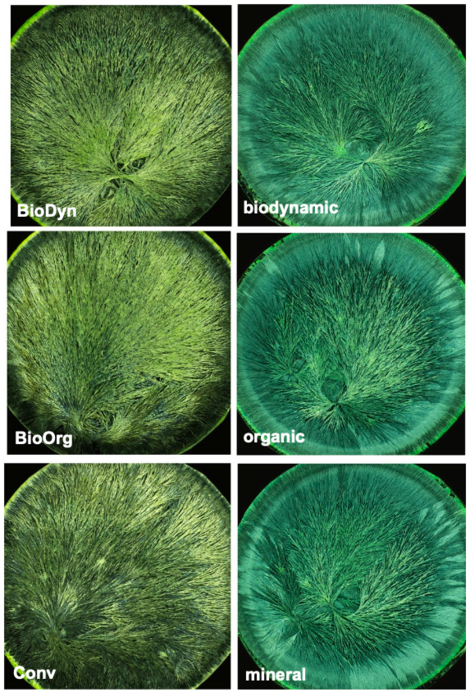Distinguishing between different agricultural practices using crystallisation patterns
In a study from 2022, a research team led by Jürgen Fritz examined crystallisation images from samples of wheat, grapes and rocket grown according to biodynamic, organic and conventional agricultural practices. Two different hypotheses are to be tested: First, the classification of crystallisation images will produce more accurate results if the evaluation includes kinaesthetic engagement in addition to purely analytical aspects. Second, an increasing degree of decomposition is observed in the samples: from biodynamic to organic to conventional farming methods. The study results indicate that samples from biodynamic production show a higher resistance to decomposition than those from organic or conventional production.
Chemical analysis of food provides information about both its content of health-promoting ingredients and the presence of harmful compounds. During the storage of raw or processed foods their chemical composition changes, often accompanied by a loss of quality. One way to visualise and measure the resistance of foods to age-related deterioration is the crystallisation method in which a food extract is mixed with copper chloride and crystallised in a Petri dish. The resulting crystal patterns provide information about the decomposition resistance of the tested extracts. The crystallisation method has been continuously refined for more than 20 years. Standards have already been developed for various food classes to assess their quality. Even if the underlying physical principles of pattern formation are still not fully understood, it is clear that the food sample influences crystal formation and branching.
A professional evaluation of crystallisation patterns requires appropriate training including a final examination. For the present study, the evaluation of crystallisation patterns was carried out using a combination of analytical perception and kinaesthetic perception with subsequent statistical evaluation. While analytical perception concentrates on quantifiable morphological features, the kinaesthetic evaluation expresses the feeling of the observer for the pattern in its entirety as an additional component.
Figure 1: Graphical representation of the study procedure: wheat, grapes and rocket were grown according to biodynamic, organic and conventional methods. Extracts were taken from the different samples and crystallised in copper chloride. The crystallisation patterns were assigned to the corresponding cultivation methods by trained personnel according to analytical and kinaesthetic approaches.
For the present study, samples of wheat, grapes and rocket were used, each produced according to biodynamic, organic and two conventional cultivation methods (with or without farmyard manure). Crystallisation patterns were created from the sample extracts, which were evaluated by people trained over several years. The individual samples were coded and presented to the evaluators independently and in random order.
In six out of seven tests conducted, the researchers' hypothesis that an evaluation according to kinaesthetic and analytical methods leads to more accurate results than an evaluation according to purely analytical methods was confirmed. Further results indicate that the classification of the degree of decomposition of a sample can also be applied to the cultivation method. This results in the following ranking of the cultivation methods in four out of five tests from a low to high degree of decomposition of the samples:
- biodynamic
- organic
- conventional (with farmyard manure)
- conventional (purely mineral)
A low degree of decomposition may indicate a higher decomposition resistance of the samples. The researchers recommend future experiments to investigate whether a higher observed decomposition resistance of the samples is related to an increased stress resistance of the plants or an increased storage capacity of the products.
Figure 2: Crystallisation images of wheat. For all four partial images, 0.24 millilitres of plant extract and 160 milligrams of copper chloride were used. The sample ageing time is 14 hours in each case. Biodyn: biodynamic; BioOrg: organic; ConFym: conventional with farmyard manure; ConMin: conventional, mineral only.
Comment
For the present study, the researchers placed great importance on a robust methodology, both in terms of the training of the people who evaluated the crystallisation patterns and in the implementation of the evaluation. This is necessary in order to be able to link the observed results to the underlying hypotheses as precisely as possible. It would be interesting to further refine the methods based on this study, for example in the context of a double-blind study or in comparison with an additional computer-assisted evaluation. Further experiments such as the comparison of the storage capacity of agricultural products that have been grown either biodynamically, organically or conventionally could lead to exciting results. Overall, the study provides a solid basis for the scientific investigation of copper chloride crystallisation patterns, even if not all the reservations about this method have been removed.
Details of the original research paper
- Authors: Fritz, J., Athmann, M., Bornhütter, R., Buscher, N., Geier, U., Mergardt, G., Scherr, C., Doesburg, P.
- Title: Analytical perception and kinesthetic engagement in evaluation of copper chloride crystallization patterns of wheat, grape juice and rocket samples from conventional, organic and biodynamic cultivation
- Journal: Chemical and Biological Technologies in Agriculture, 9, 103 (2022)
- Link: https://doi.org/10.1186/s40538-022-00361-9
Further information
- Prior study by Athmann et al. from 2020
- Research summary of the Section for Agriculture: https://www.sektion-landwirtschaft.org/en/research/sv/the-effect-of-biodynamic-preparations-on-growth-and-fruit-quality-of-giant-pumpkin-cucurbita-maxima-d-1
- Link to the original research paper: https://doi.org/10.1007/s13165-021-00347-1


